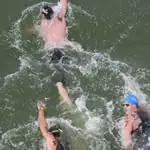
Cyclists, race car drivers and open water swimmers all know the benefits of drafting and positioning.
As swimmers take off in an open water race or triathlon and go from buoy to buoy, they create a conga line with seemingly everyone chasing after the person in front of them. Where ideally should you position yourself?
It helps to know a bit about water movement.
The Ideal Draft
A swimmer in the open water is essentially a displacement vessel. The bow wave created by a swimmer has forward and lateral movement. These waves move at an angle relative to the direction of the swimmer and are based on the swimmer's speed and size.
There are three key facts to keep in mind:
- The faster the lead swimmer, the better your draft will be with all other things equal.
- The physically larger the lead swimmer, the more beneficial the draft is for those behind.
- The closer you are to the lead swimmer, the better your draft.
The Perfect Position
In a fact known by world-class swimmers, drafting between the ankles and hips is more beneficial that drafting directly behind the lead swimmer's feet for various reasons:
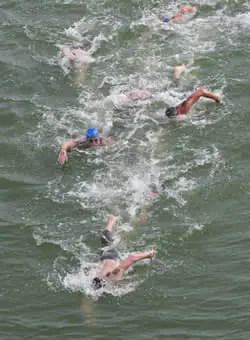
- When the drafting swimmer reaches near mid-body of the lead swimmer, the lead swimmer's wake (i.e., spreading of the bow wave) has moved laterally, so the drafting swimmer can take maximum advantage of the bow wave. That is, the drafting swimmer has reached the center of the complete wave created by the lead swimmer. Basically, the drafting swimmer is surfing a bow wave.
- The bow wave cannot extend beyond the length of the swimmer who creates it. The bow wave lifts up at the end of the swimmer's body. The most efficient swimming is when a drafting swimmer cruises in that wave. The most efficient drafting is achieved if you cruise at the same speed in the wake of the lead swimmer off to the side—but away from the eddies caused by their kick.
- In the middle of a race, when the kick of most swimmers is less than the end of the race when they are sprinting, the optimal drafting position is slightly different. At the end of the race when the kick increases, swimmers create swirls by their kick. The more swirls, the more drag. So if your opponent's kick increases, move up higher alongside their body to utilize their bow wave, but far enough away from the swirls and eddies caused by their kick.
- Combine your speed with the speed of the lead swimmer. If they speed up, you speed up. If they slow down, you slow down. If you are directly behind them, lead swimmers make the water smoother, but you are not efficiently utilizing their bow wave.
- If you swim alongside a lead swimmer, you do not have to lift your head so often to navigate. This saves energy that can be utilized at the end of the race. If you swim directly behind a swimmer, you must often lift your head to confirm your direction and position behind the lead swimmer.
- Even if the water is clear and you can easily see the lead swimmer under the surface of the water, your head is in a sub-optimal position. The most optimal head position is when you are looking straight down. This creates a more streamlined and efficient body position, saving you energy and creating less drag.
- When you swim parallel to the lead swimmer, you can effectively navigate off them when you breathe. The need to lift up your head to sight is significantly reduced and your head is positioned in the most streamlined position.
There are many other factors that come into play when drafting and positioning as world-class athletes do, but these basic factors are enough to get started.
 See more swimming tips or find swimming lessons near you.
See more swimming tips or find swimming lessons near you.
Steven Munatones is a multi-time USA Swimming national open water swim team coach, NBC Olympics marathon swimming commentator, International Marathon Swimming Hall of Fame inductee and 1982 world 25K swimming champion. He created the Open Water Swimming Dictionary, and conducts race analysis and research on open water swimming—from drafting to stroke technique—for the website dailynewsofopenwaterswimming.com.
Photos by Javier Blazquez.
Related Articles:
Get ACTIVE on the Go


Meet Mobile
Swim smarter: heats, lane assignments and real-time results in the palm of your hand.
Available for iOS | Android
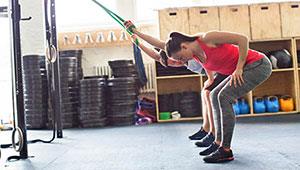

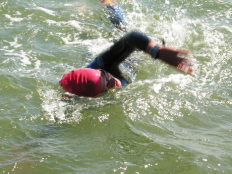
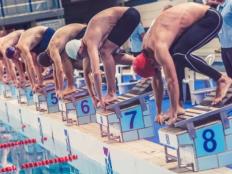
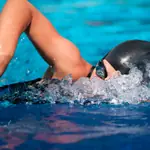


Discuss This Article